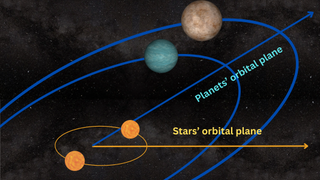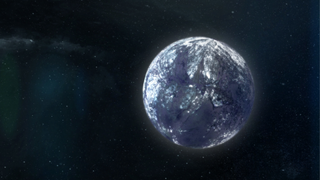Star Wars fans will definitely appreciate the binary star systems nicknamed “Tatooine” – a reference to the planet Luke Skywalker stands on to gaze upon the twin suns in Star Wars: A New Hope. It turns out that some of the planets in the real-life versions of these systems may have also received a much more literal kick.
New research suggests that “rogue planets” roaming the Milky Way – that is, planets isolated from parent stars and living as cosmic orphans – could be kicked out of dual or binary star systems. But there’s a twist (literally)!
The team discovered that rogue planets are more likely to be ejected specifically from “twisted Tatooine” systems. These are systems in which the stars and planets orbiting them are misaligned, therefore existing at tilted angles to each other.
As telescopes have improved, detection of these rogue planets has grown to the point where astronomers believe that free-floating planetary bodies far outnumber stars arranged in comfortable arrangements, such as the solar system , in the Milky Way. Recent projects put the number of rogue planets ejected from their home systems in our galaxy at one quadrillion (10 followed by 14 zeros). These twisted new discoveries from Tatooine could help explain Why rogue planets are so common.
Related: NASA’s TESS exoplanet hunter may have spotted its first rogue planet
“A normal planetary system, like our solar system, is made up of multiple planets orbiting a single star. On the other hand, binary stars are also common, accounting for more than 50% of star systems,” said Cheng Chen, team leader and astrophysicist at the University of Leeds, told Space.com. “If there are planets orbiting a binary system, we call it a ‘circumbinary planetary system’.”
Even though we know that planet formation is a byproduct of star formation, we still don’t know the planet production rates. That’s because we can’t be sure how many of them get ejected from their systems and wander the galaxy as hard-to-spot icy bodies. These would be bodies that are neither illuminated nor heated by a parent star.
“More precise demographic determinations of rogue planets can help us complete the final piece of the planet formation puzzle,” Chen said.
He went on to explain that the orbital planes of some of these planets may not be aligned with the orbital planes of their host binary stars. Astronomers call these “tilted circumbinary planets,” and studying them could reveal the dominant mechanism for generating floating planets.
Driven from their cosmic homes
Scientists believe that orphan planets form around newborn stars, just as planets that remain “bound” to their stellar parent do. Stars are essentially born from a collapsing cloud of gas and dust, but this process does not consume all of the matter in that cloud, leaving the stars surrounded by “protoplanetary disks.” Too dense regions of these disks collapse and give birth to planets. About 4.6 billion years ago, this gave birth to the solar system and its planets, including Earth.
The period following planet formation is thought to be particularly chaotic for these nascent systems, leading to “disordered” gravitational interactions that can eject planets.
In fact, researchers hypothesize that our solar system may once have had a fifth giant planet alongside Jupiter, Saturn, Uranus, and Neptune during a chaotic period called “late instability.” The idea is that this “extra” planet was displaced from its orbit, and that gravitational interactions with the other giant planets would have caused the total exile of the unfortunate planet from the solar system.
However, Chen and his team did not focus on a relatively simple single-star system like the solar system to investigate the origins of rogue planets. Instead, they focused on more complex binary star systems, like the one seen during that iconic Tatooine sunset.

“Problems with three or more bodies are much more complicated than problems with two bodies. The inner stellar binary can perturb the planet due to dynamic effects,” Chen said. “On the other hand, planet-planet interactions can also disrupt planetary orbits.”
The team simulated planetary systems in which two planets are separated by a certain distance from their stars and trace orbits inclined to the orbit of the central binary stars.
Chen and his colleagues experimented with a variety of systems exhibiting a different range of orbital inclinations and a wide range of planetary separations. They also tinkered with the masses of the planets involved while keeping one planet more massive than the other.
“We found that a massive planet like Jupiter could disrupt other smaller planets around the binary system and eject them from the system. This can happen when two planets are close together or when they are located around orbital resonance regions ” Chen said.

The University of Leeds researcher further explained that the team’s previous study found that two Jupiter-sized planets around a single star can become unstable when their separation is very small, less than two times the distance between the Earth and the Sun. In this study, however, they found that a massive planet tilted around a binary can cause ejections of smaller planets even when their separations are wider.
This surprised Chen and his colleagues, because it revealed that a more diverse array of planets could be ejected from Tatooine’s twisted systems than expected.
“Initially, we thought that only two massive planets around the binary could be ejected due to the strong dynamic effects between the two planets and planet-binary interactions,” Chen said. “We didn’t expect that small planets could be ejected so efficiently. As a result, circumbinary systems could produce rogue planets ranging from smallest to largest.”
“Small planets are more common than high-mass planets,” he continued. “Therefore, these systems could contribute to the population of rogue planets in the universe.”
This means that the systems studied by the team could explain the predicted richness of Earth-sized rogue planets.
Chen explained that the team is currently looking for other mechanisms that could also produce rogue planets. This includes the possibility that other stars could fly past planetary systems and cause a gravitational disturbance leading to a planet’s exile. This could be a rather efficient way of producing rogue planets, whether from a single star or a binary system.
Chen is unlikely to abandon his investigation into rogue planets. That means the Taiwanese astronomer’s efforts could help bring these cosmic orphans freed from their stars “out of the cold” — at least figuratively speaking.
“I love planets! When I was 8 years old, I decided to become an astronomer and studied all nine planets in our solar system before Mike Brown changed that by reclassifying Pluto,” Chen joked. “However, nowadays more than 10,000 exoplanets have been discovered, exhibiting unexpected characteristics for us to study. Rogue planets are not alone; we should not leave them orphans but consider them as members of our global family.”
The team’s research is published in The Astrophysical Journal Letters.